Revealed: The scariest airport landings in the world
White knuckle rides

RPE/ Albert Nieboer/dpa/Alamy Live News
Just setting foot on a plane can be scary enough, but these terrifying runways amp up the fear factor even more. From narrow landing strips that stretch into the middle of the ocean to those precariously perched in steep hillsides, these incredible runways are sure to provide a thrill for even the most frequent flyers.
In our opinion, these are the scariest airport landings in the world. Read on to see how we've ranked them...
25: Gisborne Airport, New Zealand
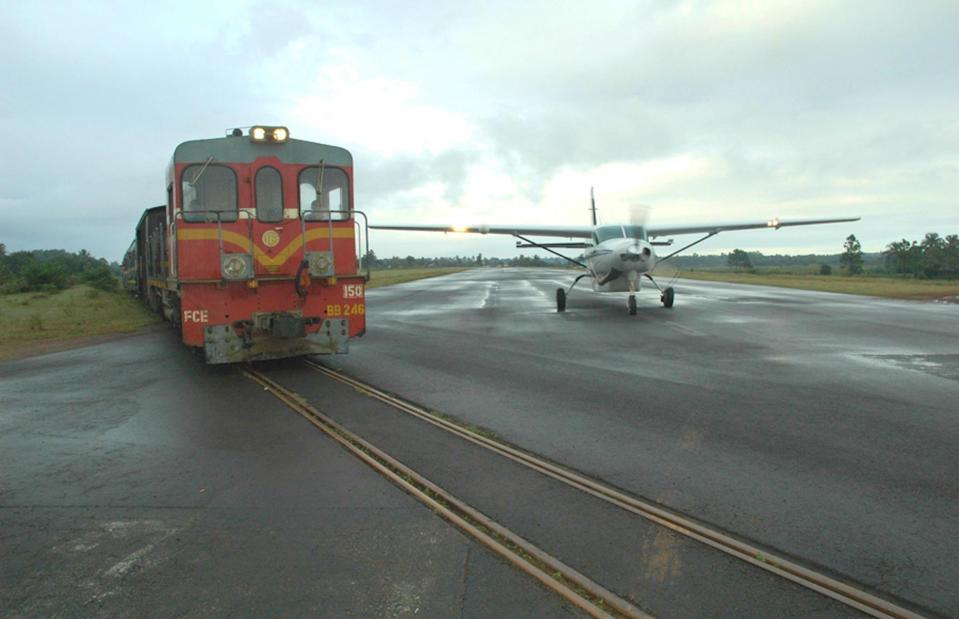
Chirlula/Wikimedia Commons/CC BY-SA 2.0
No, you’re not imagining it: that really is a train you see chugging across the runway of this little regional airport in New Zealand. In fact, it’s the Palmerston North–Gisborne Line, which crosses straight through Gisborne Airport on the east coast of the North Island, making it the only airport in the Southern Hemisphere with a railway line crossing the main runway.
25: Gisborne Airport, New Zealand

Hugh Mitton/Alamy Stock Photo
If your mind's racing at the thought of spectacular train-plane collisions, and the deadly consequences of such a scenario, fear not. These days, the local steam train only crosses the runway about 15 times a year with everything being safely coordinated by the airport's air traffic control tower when it happens. The driver of the train is in regular communication with the tower, pulling up at a safe distance from the runway before being given the all clear to cross. It's an airport first, train track second, so planes take precedence here.
24: Gibraltar International Airport, Gibraltar
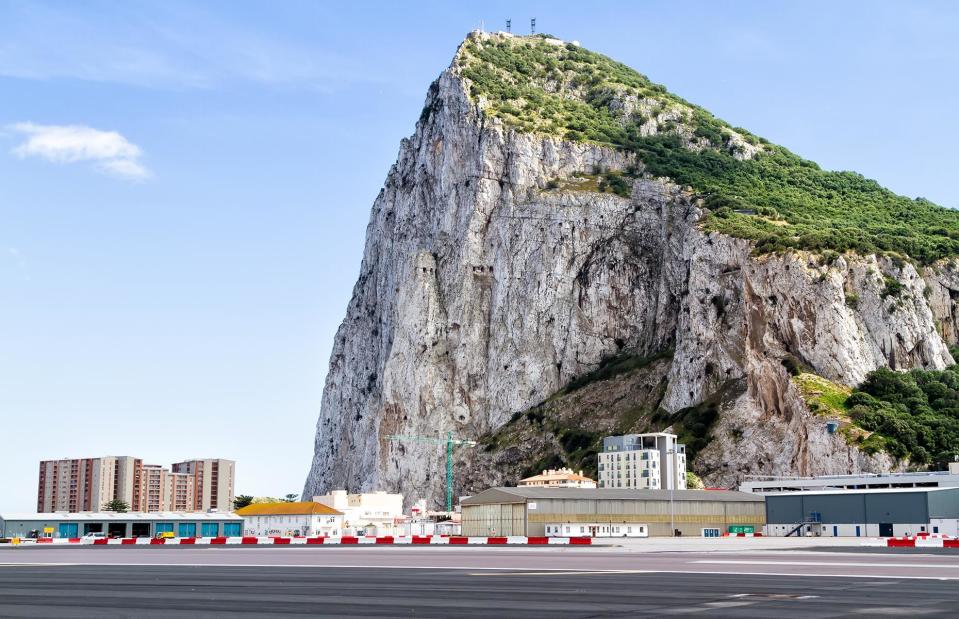
Milosz Maslanka/Shutterstock
It’s not so much the famous Rock of Gibraltar or the difficult wind conditions that make flying into (or taking off from) this destination a scary experience, although they definitely don’t help matters...
24: Gibraltar International Airport, Gibraltar
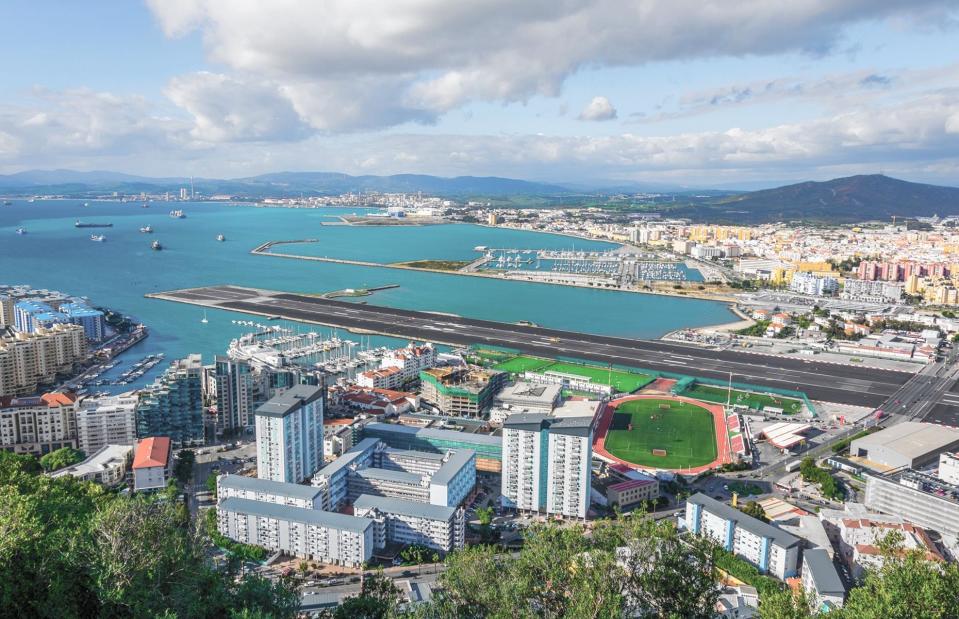
trabantos/Shutterstock
The really precarious thing about Gibraltar's airport is that spending a moment too long on the runway means you’ll end up in the sea. That's right – it's surrounded by water at both ends. There's also a main road which leads to central Gibraltar crossing the runway. Traffic is stopped by a pair of barriers up to 10 minutes before a landing or take-off.
23: Cristiano Ronaldo Airport, Madeira, Portugal
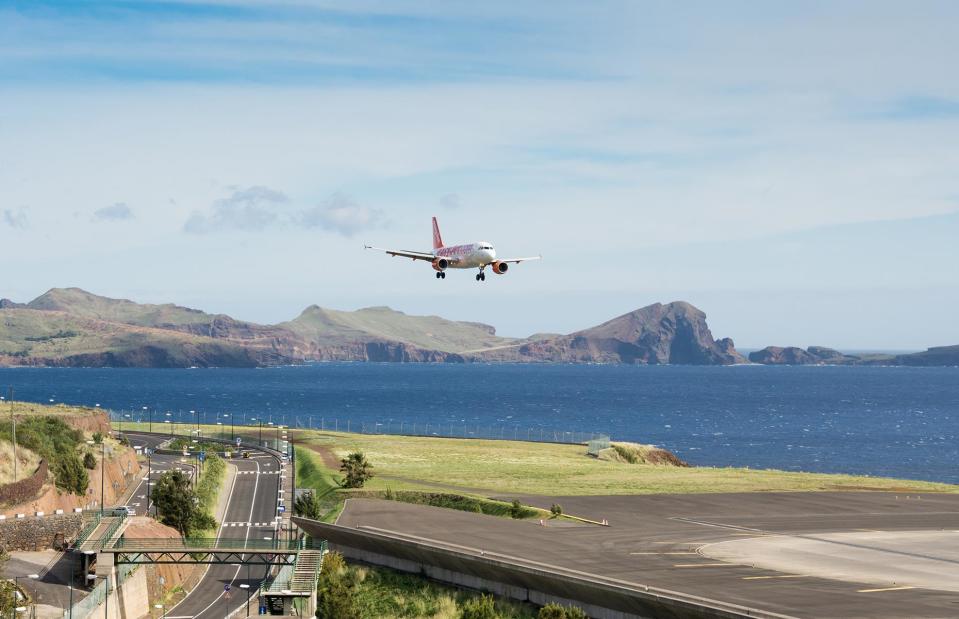
Alberto Loyo/Shutterstock
It may look pretty but the landing strip at this Portuguese archipelago's airport, which shares its name with Portugal's most successful and famous footballer, is often at the mercy of incoming weather fronts that create unpredictable turbulence even on the clearest of days.
23: Cristiano Ronaldo Airport, Madeira, Portugal
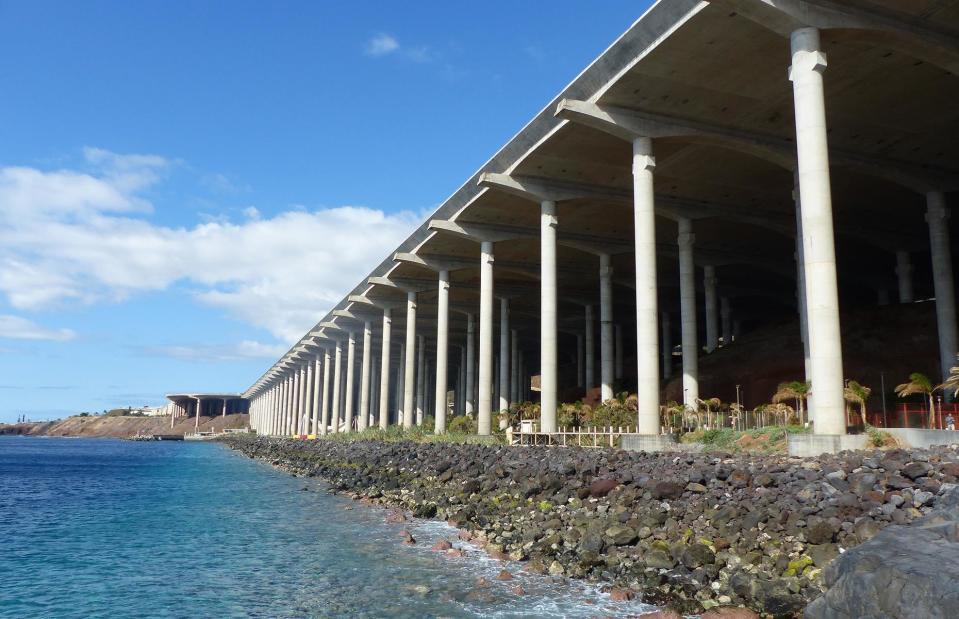
guentermanaus/Shutterstock
Madeira’s increasing popularity as a tourist destination has seen the runway extended multiple times to accommodate larger aircraft. Instead of reclaiming land, though, the runway was built on stilts and partly covers the Atlantic. The fierce crosswinds, combined with its proximity to nearby mountains, sometimes makes for a heart-stopping few hours hovering at 14,000 feet (4,267m) waiting for the weather to subside.
22: Queenstown Airport, New Zealand
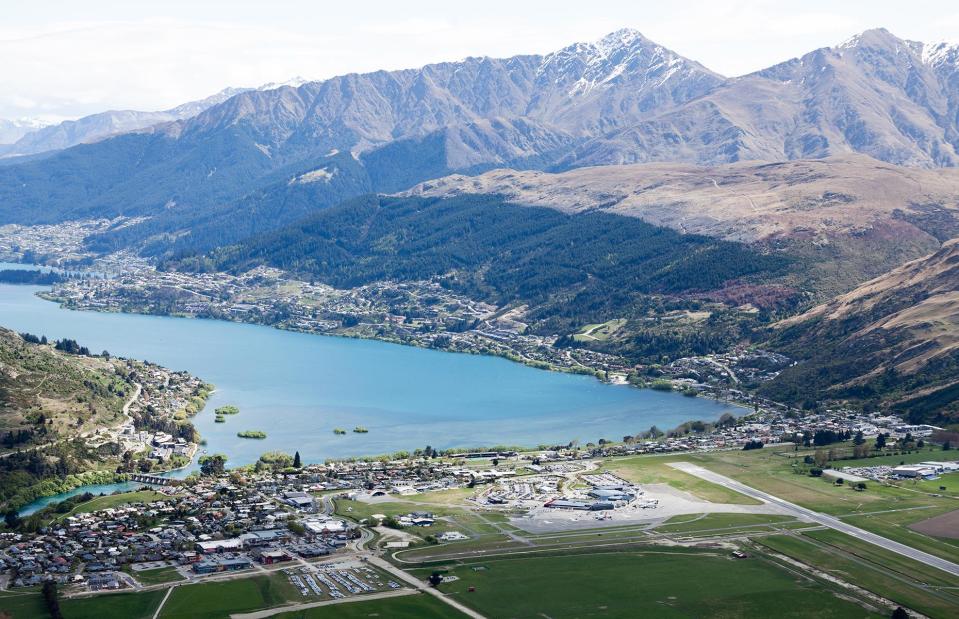
alexfe/Shutterstock
En route to Queenstown, planes have to negotiate a craggy mountain region with frequent high winds and sideways rain. Thankfully, a series of special procedures ensure safe operations, which is fortunate since evening flights were introduced for the first time in 2016.
22: Queenstown Airport, New Zealand

Adwo/Shutterstock
While the descent is stunning, landing here can take your breath away as the tips of the plane wings appear to touch the side of the snow-capped mountains above the edge of Lake Wakatipu. If the plane overshoots the runway, it could end up in the fjords.
21: Tioman Airport, Malaysia
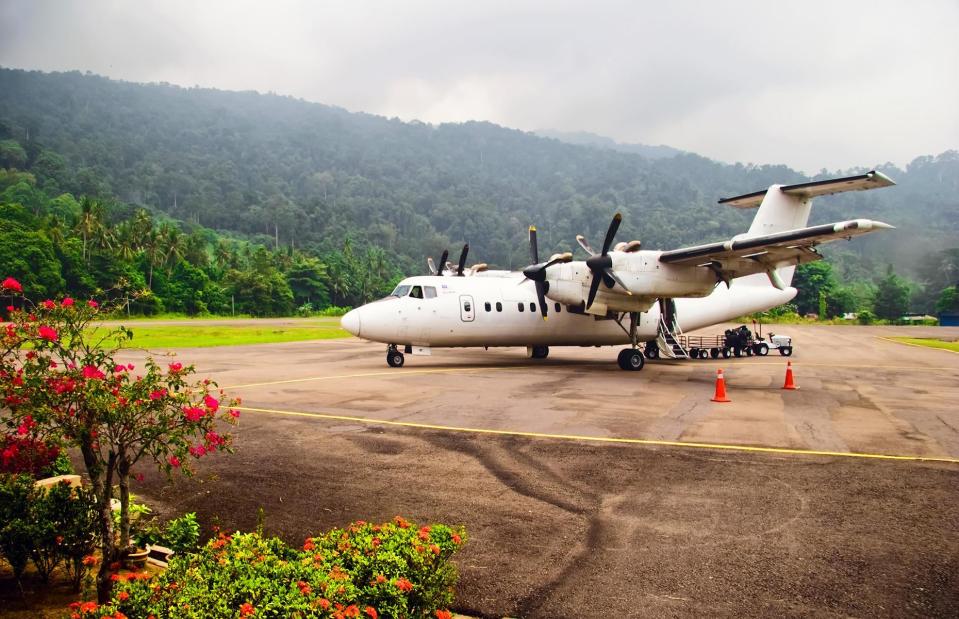
DeltaOFF/Shutterstock
Only two airlines serve this tiny island airport from Kuala Lumpur, and that's just as well, because the runway is a one-way street. Precision is required coming in to make a sharp 90-degree turn around a mountain, and pilots must then immediately decelerate to avoid a sheer drop at the strip's end.
21: Tioman Airport, Malaysia

fabien astre/Alamy Stock Photo
In the early years of the 21st century, plans were put forward to create a new airport for Tioman. The proposal included a 6,562-foot-long (2,000m) runway which would have allowed bigger planes like the Boeing 737 to land. Concerned by the environmental impact of the plans though, the locals protested and the plans were halted. At the end of 2024, the Prime Minister of Malaysia announced Tioman Airport would be allocated the equivalent of just over £8 million ($10.5m) to improve passenger facilities and extend the runway to 4,265 feet (1,300m). Good news for nervous flyers.
20: Vagar Airport, Faroe Islands

TomaszWozniak/Alamy Stock Photo
Up in the North Atlantic Ocean, situated between Iceland and the Shetland Islands, the 18 isles that make up the Faroe Islands archipelago are a self-governing territory within the Kingdom of Denmark. Visitors to Vagar Airport, the territory's only airport, are often treated to spectacular views of the epic volcanic terrain as they come into land. This otherworldly airport is not for the faint-hearted though...
20: Vagar Airport, Faroe Islands

FRANCK FIFE/AFP via Getty Images
Because the Faroe Islands is so exposed to the elemental power of the North Atlantic, pilots bringing down their planes at Vagar Airport often have to confront the incredibly forceful and unpredictable winds that the territory is famous for. This can make things bumpy, to say the least. Making matters worse is the poor visibility and seemingly relentless rain that can roll in out of nowhere here.
19: Wellington International Airport, New Zealand
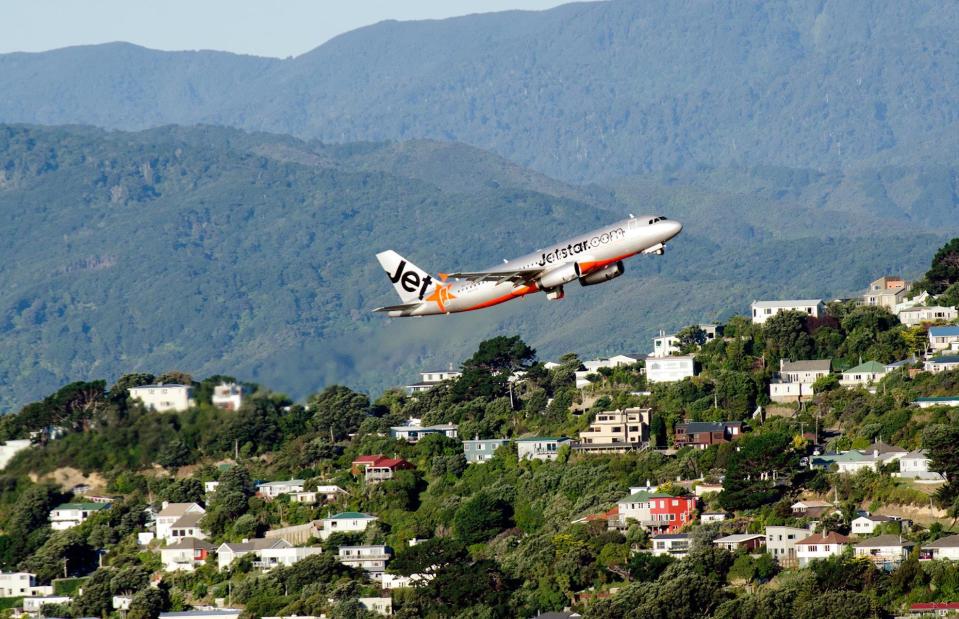
ChameleonsEye/Shutterstock
Although the runway itself is built on low-lying land by the sea, it’s incredibly close to the New Zealand capital's suburbs and the surrounding mountains. That, coupled with the unpredictable air currents and strong cross winds, means that you can be in for a bumpy ride – and landing.
19: Wellington International Airport, New Zealand

Danita Delimont/Alamy Stock Photo
Many travellers to New Zealand will be able to regale you with dramatic tales of landing at windy Wellington. Despite the stories and the sweat-inducing video evidence on YouTube of planes making their descents in the world's windiest city, the airport itself has an excellent safety record. Something to tell yourself when your fingernails are digging into the armrests.
18: Velana International Airport, Male, Maldives
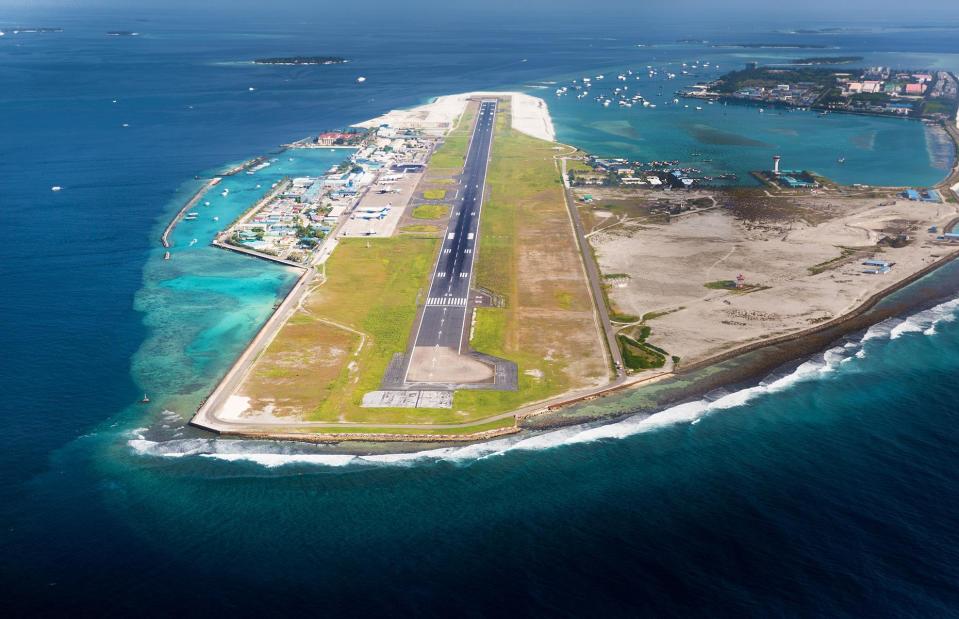
klempa/Shutterstock
Velana is the main international airport for the Maldives, located on Hulhule Island on the North Male Atoll. So if you want to dip your toes in the pristine blue waters, you’ll have to stomach the gut-wrenching landing that almost sees your plane take a dip too.
18: Velana International Airport, Male, Maldives
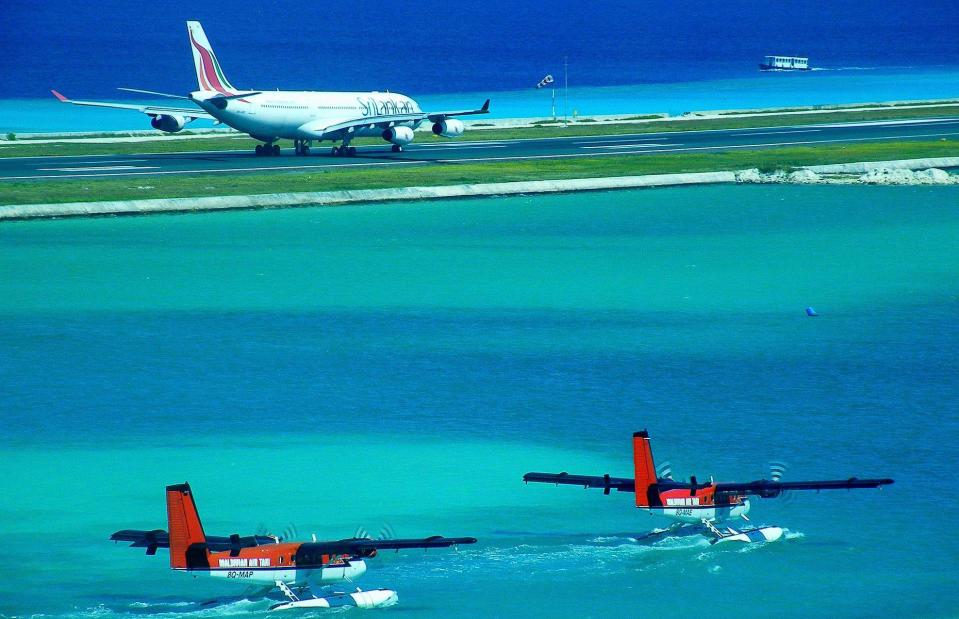
╚ DD╔ from Male, Maldives, CC BY-SA 2.0, via Wikimedia Commons
Scary but beautiful, passengers are usually more worried about onward journeys to resorts that are generally made by seaplane. The tiny aircraft can safely carry up to 15 passengers but taking off and landing on water sometimes freaks newcomers out.
17: Svalbard Airport, Norway

Fasttailwind/Shutterstock
Surrounded by the icy wilderness of the Svalbard archipelago, this airport is the northernmost commercial airport in the world. It's scary because it's built on (insulated) permafrost and has no runway lights. That's fine until you realise that Svalbard is so far north that the sun barely rises at all here during the winter months.
17: Svalbard Airport, Norway

Photo by JONATHAN NACKSTRAND/AFP via Getty Images
Situated just over three miles (5km) from Longyearben, this intimidating airport sits in the shadow of the Gruve 3 coal mine and the Svalbard Global Seed Vault. The latter, which has been dubbed Earth's 'doomsday' vault, is the world's largest backup facility for seeds and acts as insurance against the loss of crop diversity. Once you've landed on Svalbard, things don't necessarily get any less scary. Polar bear sightings and encounters are common on the Norwegian archipelago.
16: Agatti Airport, Lakshadweep, India

Julio, CC BY-SA 2.0, via Wikimedia Commons
Never has a potentially scary airport landing felt quite as paradisiacal as the one pictured here. Situated off the coast of Kerala, the breathtaking tropical archipelago of Lakshadweep is a union territory of India made up 36 islands. Those wishing to visit this beautiful part of the world by air basically only have one option: book yourself a ticket on a plane heading to Agatti Airport, the region's only runway, and make your way from there. For pilots coming into land at Agatti, it goes without saying that precision is the name of the game.
16: Agatti Airport, Lakshadweep, India

NJOSEPHOTO/Alamy Stock Photo
Measuring just 3,950 feet (1,204m) long and 98 feet (30m) wide, it doesn't take a leap of the imagination to envisage the plane you're flying in going for a swim here. The margin for error feels tiny. What's more, because mainland India is 245 miles (394km) away to the east, and the runway is on such a narrow part of the island, the descent can – for passengers brave enough to look out of the window – feel as if you're heading into the huge expanse of blue. Don't reach for the lifejacket though. It's all just part of the Agatti experience.
15: Kansai International Airport, Osaka, Japan

FantasticJapan/Alamy Stock Photo
Back in 1994, when it first opened, Kansai International Airport was being talked about as the most unique and impressive airport in the world. And, to give the airport its due, in the 30 years since it began operations, it has maintained an astonishing record of never losing a single item of luggage. This, despite serving tens of millions of passengers every year. However, things aren't all rosy at this airport built on artificial islands in Osaka Bay. In fact, it's got a scary secret...
15: Kansai International Airport, Osaka, Japan

Yamaguchi Haruyoshi/Sygma via Getty Images
Once considered a marvel of modern engineering, the airport is actually sinking at an alarming rate. Since opening, Kansai International has already sunk more than 38 feet (12m). Some engineers have even predicted that sections of the airport's islands may sink another 13 feet (4m), to sea level, by 2056. Despite a whopping £117 million ($153m) being spent on raising the airport's seawall, critics have labelled the efforts a futile attempt to prevent the inevitable. In 2018, deadly Typhoon Jebi wreaked havoc at the airport – flooding the building and stranding thousands of passengers.
14: Narsarsuaq Airport, Greenland

Bjarki Reyr/Alamy Stock Photo
Don't be fooled by this stunning view from up high. Pilots have to negotiate the icy mountains in this remote part of Greenland – landing even involves flying up a fjord – and fog and high winds are common. Night landings and take-offs are banned completely here.
14: Narsarsuaq Airport, Greenland

Paolo Reda - REDA &CO/Alamy Stock Photo
Built by the War Department of the United States in 1941, Narsarsuaq Airport was once known as Bluie West One. Starting life as a base of operations for allied convoy escorts and anti-submarine missions, the airfield facilities have thankfully been improved in the decades since. The talented pilots serving the region's increasing civil aviation traffic and tourist numbers know all about the extreme weather and terrain here, trusting their cockpit's instruments and making the most of those good visibility windows when needed.
13: Congonhas International Airport, Sao Paulo, Brazil
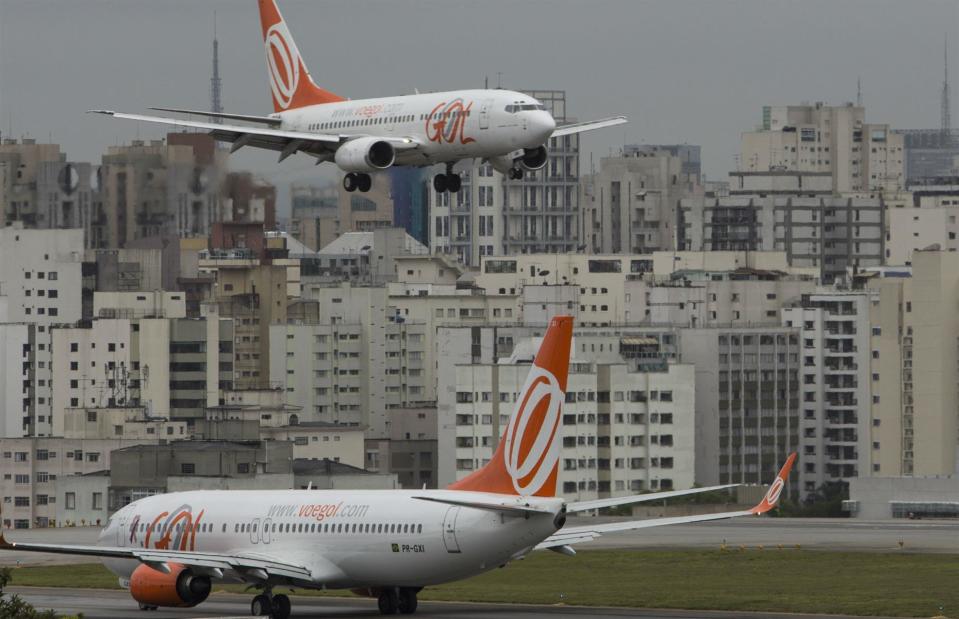
Miguel Schincariol/AFP via Getty Images
This Sao Paulo airport is a scary spot to land. Famed for its risky runways that were long accused of being the slipperiest in the world, the airport is located in a dense built-up area of the city, meaning that planes have to negotiate a slew of high-rise buildings. Passengers feel like their plane is scraping the tops of skyscrapers as they come down to land.
13: Congonhas International Airport, Sao Paulo, Brazil

Stefan Lambauer/Alamy Stock Photo
In July 2007, Congonhas Airport was the scene of a tragic accident when a TAM Airlines Airbus A320 overran the runway in heavy rain and hit a warehouse and gas station. Resulting in the death of 187 passengers and crew, as well as 12 people on the ground, the crash is the deadliest aviation accident in South American history. In 2022, the airport installed an Engineered Material Arresting System (EMAS). This foamed silica bed made from recycled glass is reassuringly designed to stop aircrafts overrunning a runway when landing.
12: Kushok Bakula Rimpochee Airport, Leh, India
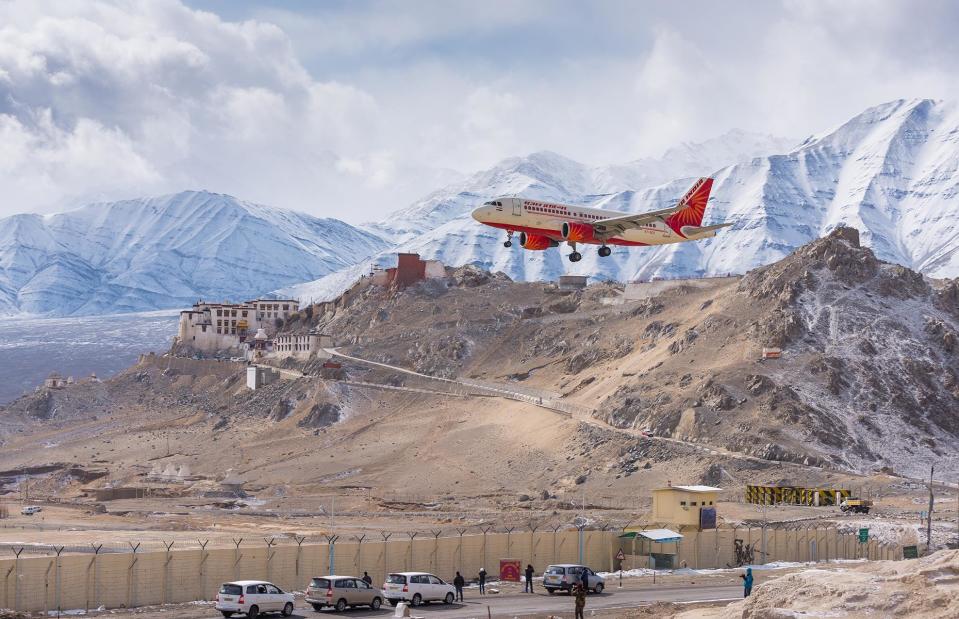
GoBOb/Shutterstock
Situated in the heart of the Himalayas mountain range, Leh's airport is often ranked among the most scenic approaches in the world. It’s also one of the highest at 10,600 feet (3,256m) above sea level, and because of fierce afternoon winds planes only take off and land in the mornings.
12: Kushok Bakula Rimpochee Airport, Leh, India
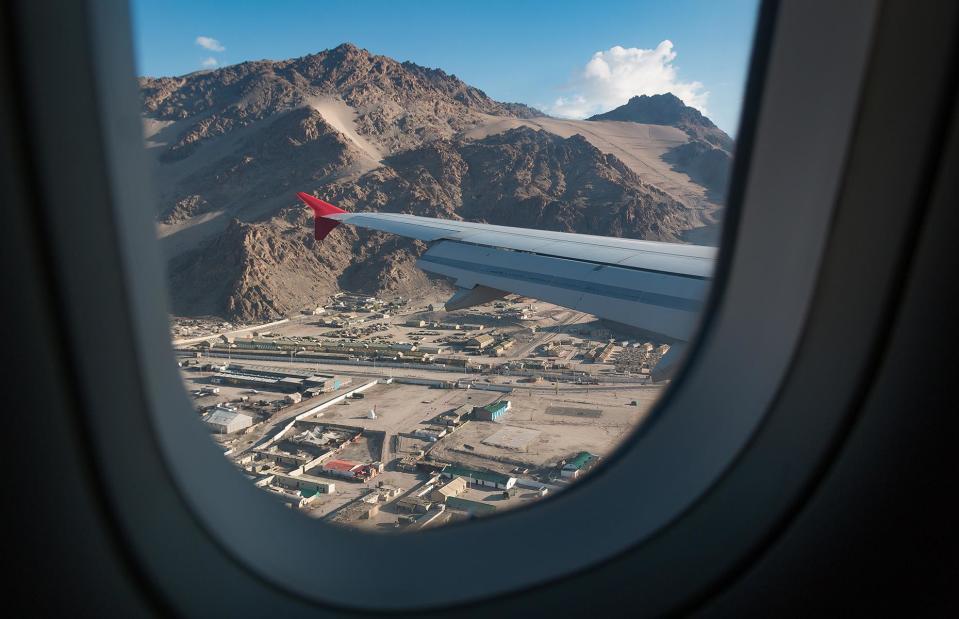
tonbluesman/Shutterstock
Unfortunately, you won't be able to rely on your comfort blanket as your plane dodges the peaks – hand luggage is forbidden. Airport security is incredibly tight in this region of India and passengers have to comply with much stricter checks.
11: St Helena Airport, St Helena

Simon Benjamin/Alamy
When St Helena's airport first opened it was dubbed 'the world's most useless airport' as it could only accommodate small aircraft and battled repeatedly with the weather. The winds here can change speed and direction in a split second, which is very dangerous for take-offs and landings. During trial flights in 2016, it took a Boeing 737-800 three attempts to land. A former pilot has called the landing "hair-raising".
11: St Helena Airport, St Helena

Craig Hallewell/Alamy
Since then, wider runway shoulders, extensions and turning circles have been added, and the length of the runway extended to 1.2 miles (1.9km), which means it can welcome aircraft like the Boeing 757. However, the weather conditions and sheer cliffs have not changed, meaning it's still classed as a category C airport, so only specially trained pilots and crew can land.
10: Barra Airport, Scotland, UK
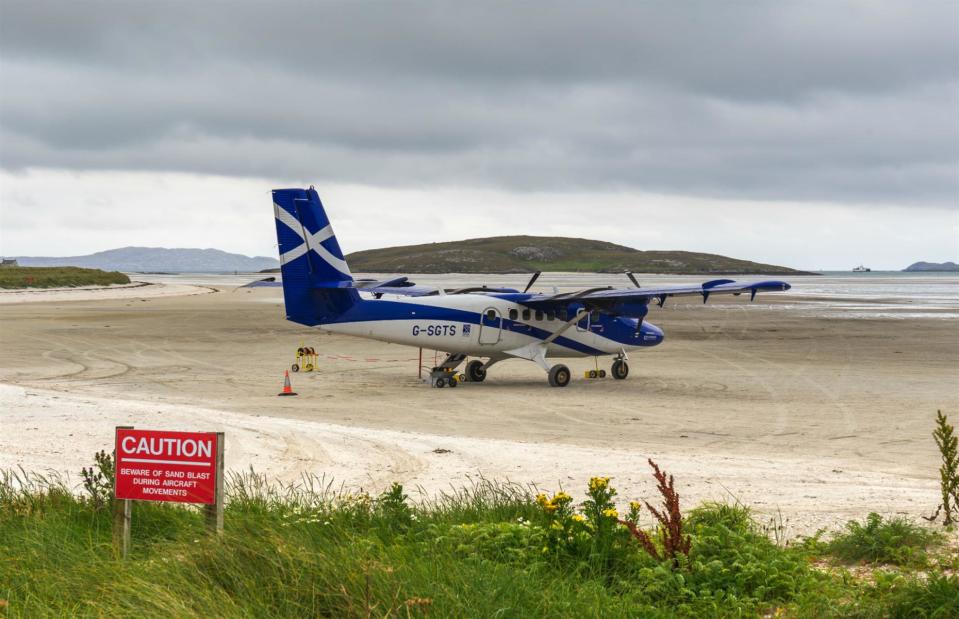
EyesTravelling/Shutterstock
This airport on the tiny island of Barra in the Outer Hebrides, off the west coast of Scotland, is the only place in the world where scheduled flights land on the beach. It now serves over 14,000 passengers annually.
10: Barra Airport, Scotland, UK

Richard Murphy Fine Art/Shutterstock
The beach has three runways, which means that planes can almost always land with the wind in the right direction. The whole area is submerged by the sea at high tide so the schedule changes from day to day. While a flight landing here can offer beautiful views, it's also rather disconcerting to think that your landing is relying on the rise and fall of the sea.
9: Skiathos International Airport, Greece
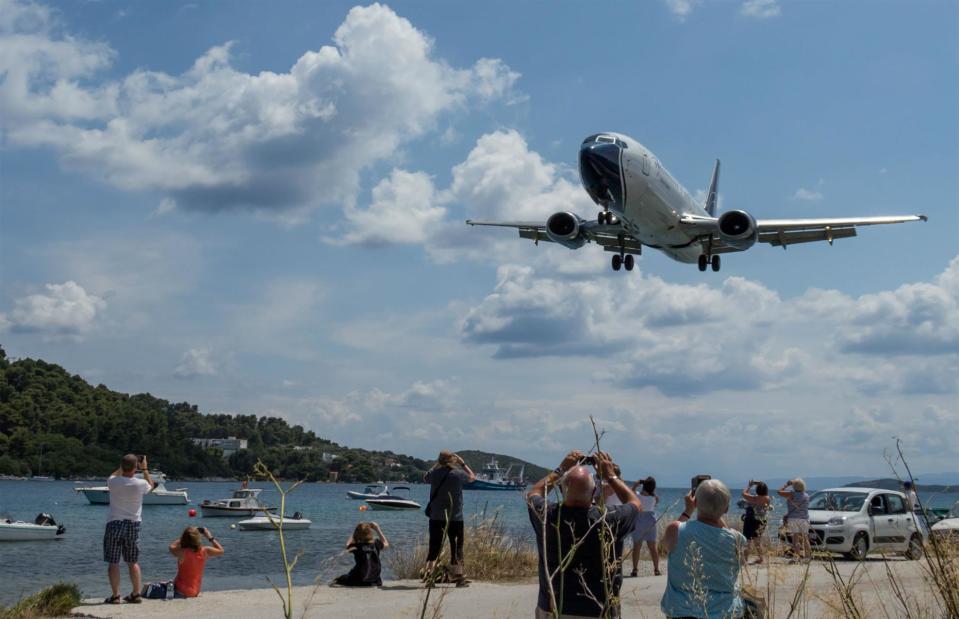
Marija Vujosevic/Shutterstock
This diminutive, craggy Greek island only got an airport after reclaiming land from the sea between it and the neighbouring island of Lazareta. It's not surprising that this move has resulted in a few hair-raising moments not only for passengers but for beachgoers too...
9: Skiathos International Airport, Greece
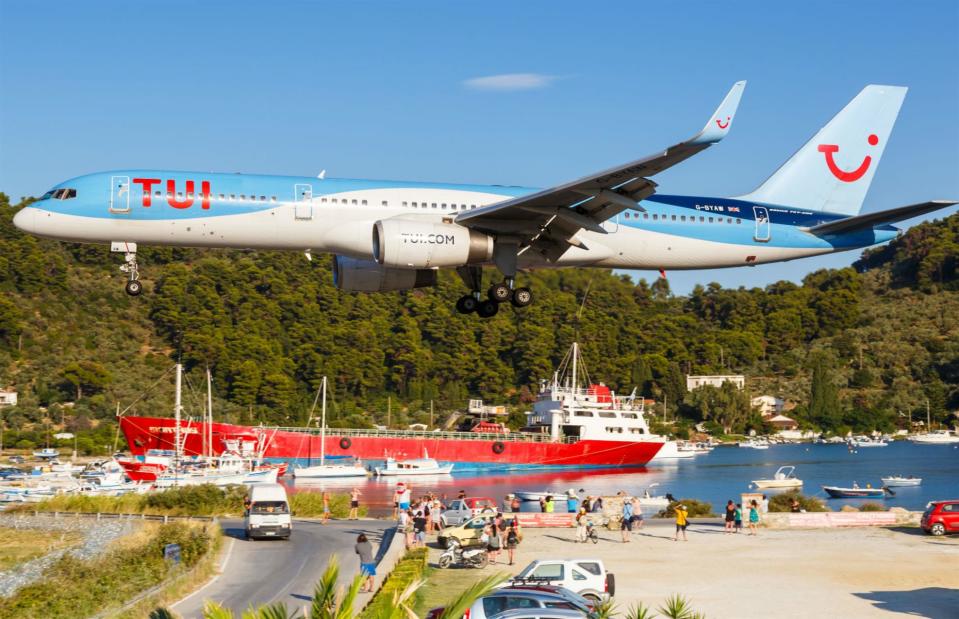
Markus Mainka/Shutterstock
Planes fly so low over the nearby beach and road that those sunbathing or in traffic can probably see what passengers had for their in-flight meals. The surreal experience attracts plane spotters from all over the world. Dubbed 'the St Maarten of Greece', in reference to a very similar scene on a Caribbean island (see later in this gallery), the landing is even scarier for the passengers looking out of their windows.
8: Antarctica

Marc Bow/Speedstream Films
Clapping when the plane lands is considered bad form by many, but we can forgive the passengers on this momentous flight. Operated by Hi Fly, this Airbus A340 was the first ever to land in Antarctica, touching down on the icy runway on 2 November 2021. That was after a journey of more than 2,500 nautical miles (4,630km), from Cape Town, South Africa.
8: Antarctica

Marc Bow/Speedstream Films
According to pilot Carlos Mirpuri, the white snowy terrain makes it harder to judge distance and the pilot has to wear special eyewear to reduce glare. Despite all these challenges, it was said to be a smooth landing and the rest of the journey went according to plan. Although there are concerns over the impact overtourism could have here, many hope that A340 planes can be used in the future to transport tourists and researchers to Antarctica.
7: Princess Juliana International Airport, St Maarten

mariakraynova/Shutterstock
This famous, extremely low approach looks too close for comfort for all involved. But the landing strip at St Maarten's Princess Juliana International Airport bumps right up against the sea and pilots must keep a close eye on their altitude – as well as sunbathers – as the plane passes narrowly over Maho Beach.
7: Princess Juliana International Airport, St Maarten
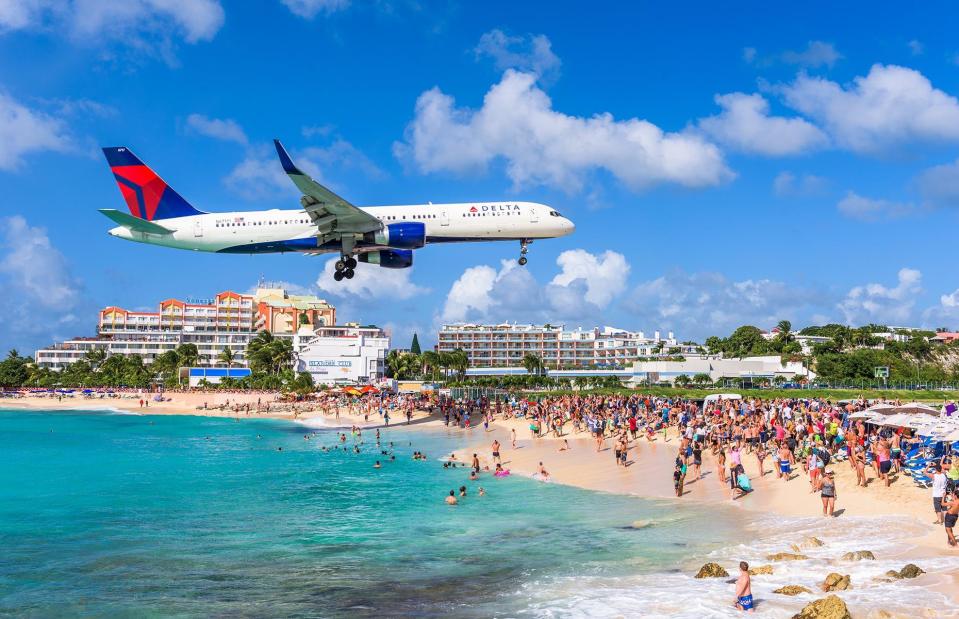
Sean Pavone/Shutterstock
The beach has become a popular spot from which to watch planes. There are certainly plenty to see and hear. Thrill-seekers line up at the fence to feel the force (not recommended), and the deafening plane noise combined with high winds makes for an intense experience. Passengers inside the aircraft, meanwhile, often have their hearts in their mouths.
6: Gustaf III Airport, St Barts
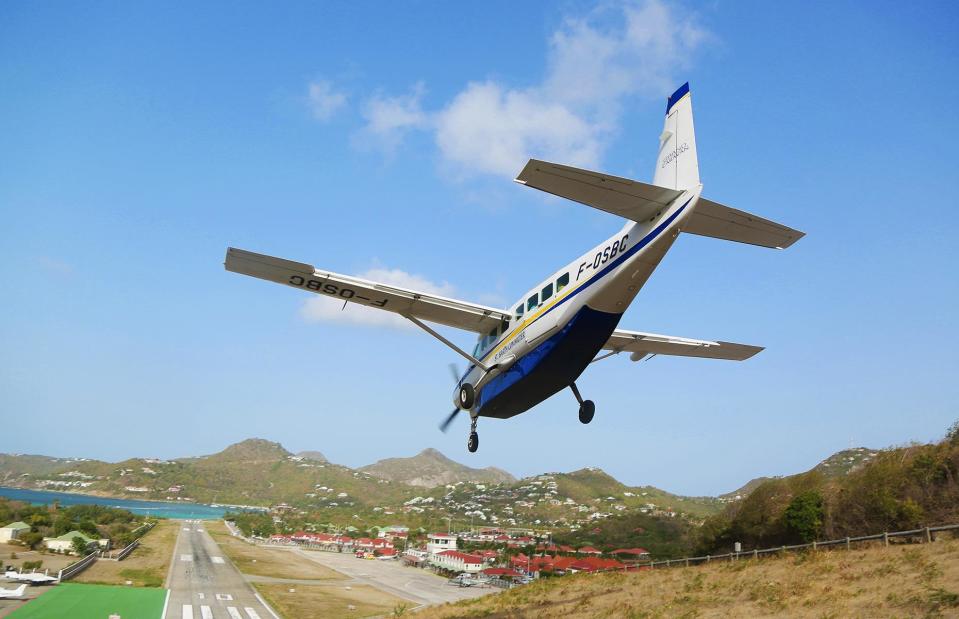
Leonard Zhukovsky/Shutterstock
This runway on the French Caribbean island of St Barts is crammed between a steep hillside at the approach end and the deep blue sea at the other. Add to the mix the proximity of local roads and you’ll want to close your eyes as you fly in – or wave to wide-eyed drivers in the passing traffic.
6: Gustaf III Airport, St Barts

Naeblys/Alamy Stock Photo
Despite the airport's idyllic setting, Gustaf III is thought to be one of the most dangerous airports on the planet. The sense of peril for pilots and passengers stems, in part, from the shortness of its runway that measures just 2,132 feet (650m) in length. When you factor in the high hills of nearby terrain, which forces a steep descent during landing, as well as the beach literally sitting at the end of the runway, the margin for error here can start to feel scarily small. No wonder pilots need specific training and certification before hitting this potentially terrifying stretch of tarmac.
5: Toncontin Airport, Tegucigalpa, Honduras

Oscar Josue Elvir Vasquez/Wikimedia Commons/Public domain
Ranked the second most extreme airport landing in the world by History Channel programme Most Extreme Airports, Toncontin Airport in the Honduran capital of Tegucigalpa nails the holy trinity of difficult airport landings: a short runway, mountainous terrain and high winds.
5: Toncontin Airport, Tegucigalpa, Honduras

ORLANDO SIERRA/AFP via Getty Images
Pilots must make a sharp turn to align with the airport as part of their approach, and its notorious single runway is too short to accommodate planes larger than Boeing 757s. The altitude (around 3,300 feet/1,000m) throws unpredictable weather into the mix, and the densely packed urban neighbourhoods around the airport do little to ease nerves. Tragically, five people died when a plane overshot the runway in 2008.
4: Juancho E Yrausquin Airport, Saba

Bildagentur Zoonar GmbH/Shutterstock
At only 1,312 feet (400m) long, the landing strip at Juancho E Yrausquin Airport on the Dutch Caribbean island of Saba is the shortest commercial runway in the world. It also has a steep drop into the sea at both ends, which makes for some nail-biting take-offs and landings.
4: Juancho E Yrausquin Airport, Saba

RPE/ Albert Nieboer/dpa/Alamy Live News
However, those that dare board a helicopter or turboprop plane (the only aircraft allowed to land here) from sister isle St Maarten will be wowed with incredible views of the volcanic island. The flight is only 12 minutes – but they will be memorable minutes.
3: Courchevel Altiport, France
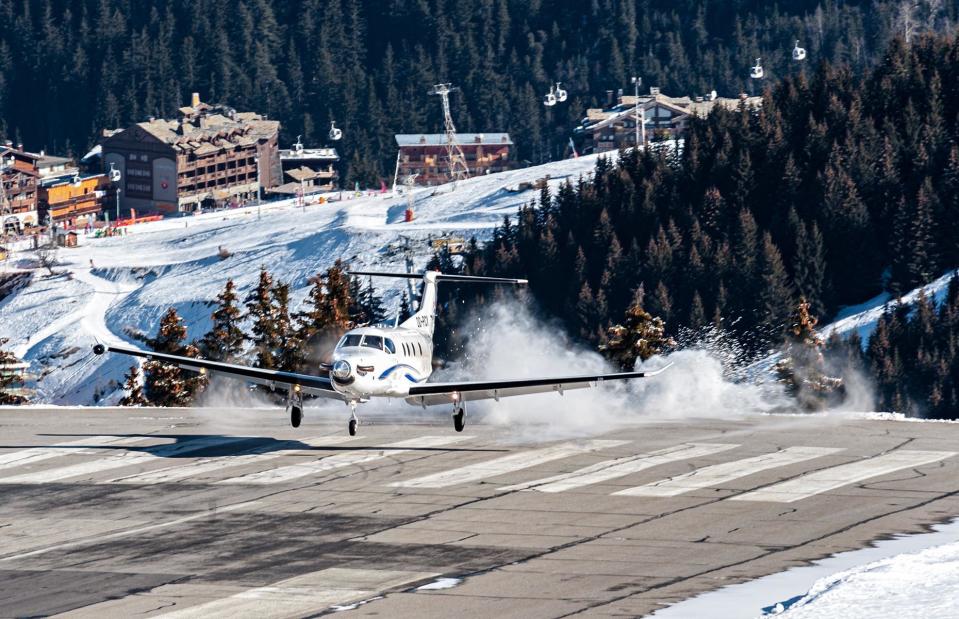
Roberto Chiartano/Shutterstock
As if the towering Alps surrounding the French ski resort of Courchevel weren’t enough of a challenge for pilots, this altiport (meaning a small airfield at high altitude) has one of the world's shortest runways at 1,761 feet (537m) long. Not much room for error!
3: Courchevel Altiport, France
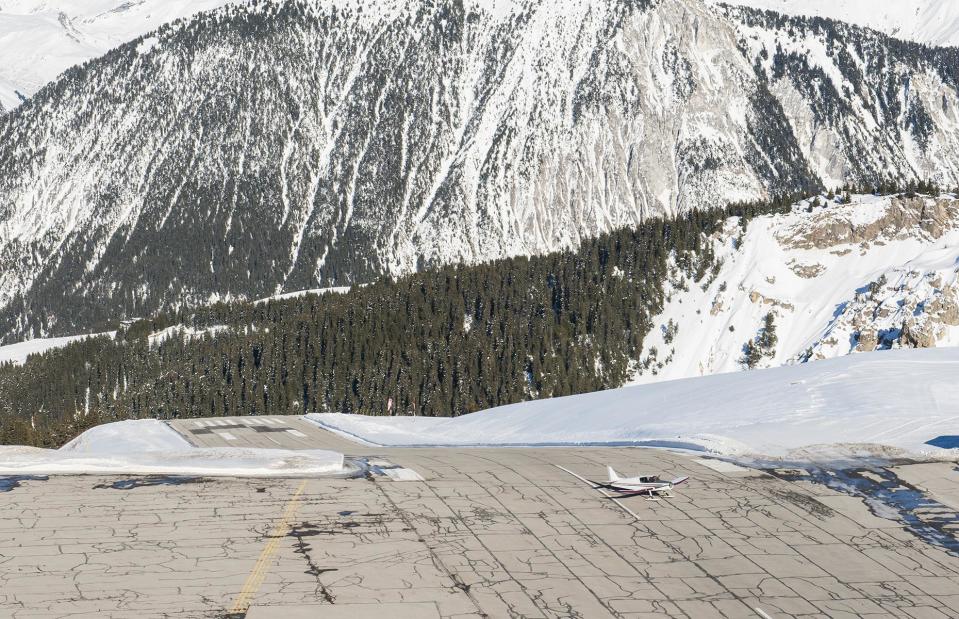
Paul Vinten/Shutterstock
The runway is sloped upwards to a gradient of 18.66% – the highest gradient in the world no less – and, owing to its proximity to the ski resort and passing skiers, it’s probably just as scary being on the ground as in the plane.
2: Paro International Airport, Bhutan
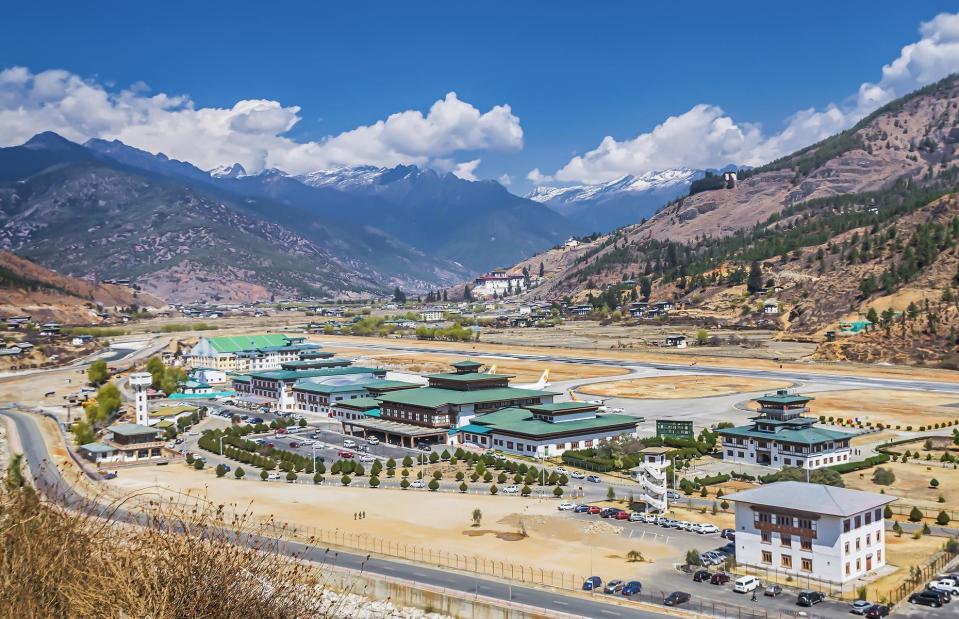
ultramansk/Shutterstock
Located in a valley at 7,300 feet (2,225m) above sea level and surrounded by lofty peaks reaching 18,000 feet (5,486m), planes must take a tight line through a narrow gap in the mountains – in daylight hours only – to reach a runway that's only visible moments before landing. It’s no surprise, then, that there’s only a handful of pilots worldwide who are trained sufficiently to do this. Rather them than us!
2: Paro International Airport, Bhutan

Cindy Hopkins/Alamy Stock Photo
Unlike most airports, there is no radar or automated guidance systems here to guide planes down to Earth. Pilots must rely on a fully manual approach, finding their way using a predetermined set of procedures. This complete reliance on visual landmarks during the descent is scary enough, before you even factor in the strong winds and overbearing cloud formations that the surrounding valley is known for.
1: Tenzing-Hillary Airport, Lukla, Nepal
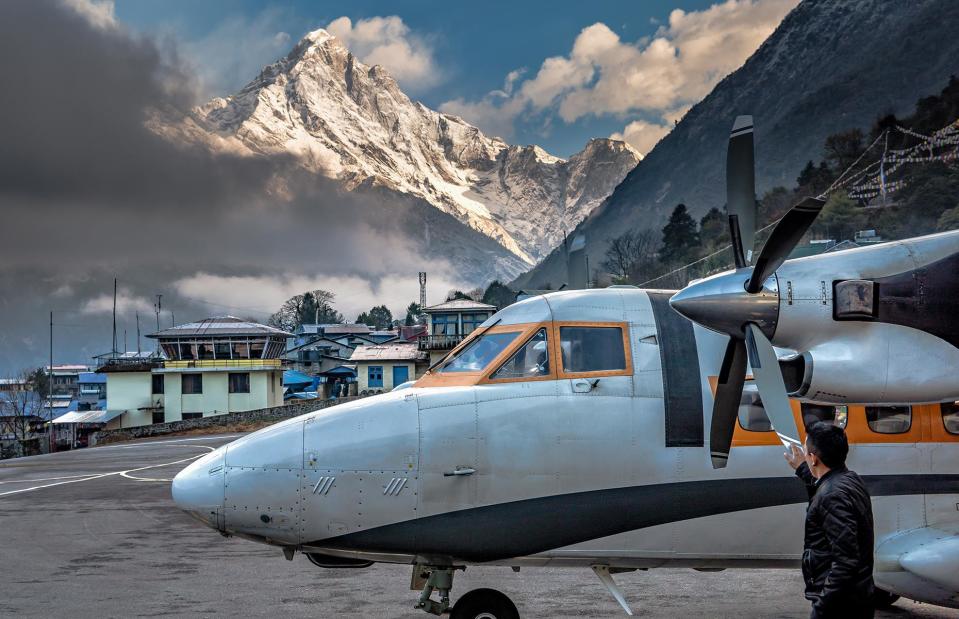
mbrand85/Shutterstock
If you’re planning on visiting Everest Base Camp, the chances are you’ll need to go via this mountain landing strip, which tops our list of the scariest airport landings in the world. The approach through the snowy peaks is a challenge designed for only the most experienced pilots and landing requires precision so as not to slam into the mountain at the end of the runway. There are no second chances here.
1: Tenzing-Hillary Airport, Lukla, Nepal
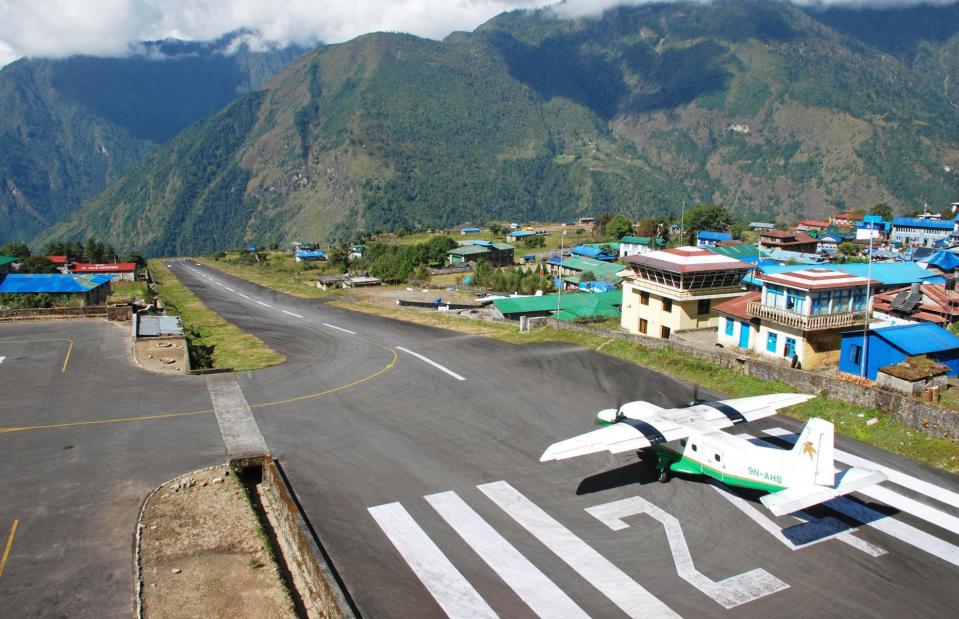
Jiri Foltyn/Shutterstock
Needless to say, it's not a journey for the faint-hearted, with a 2,000-foot (610m) sheer drop at one end of the runway. Taking off isn’t any less hairy as the runway is only 1,729 feet (527m) long. Sometimes this unique airport has to close briefly during the morning due to strong southwest winds.
Now see how much air travel changed has changed in the last 100 years


